Financial Analysis of Lehman Brothers: A Case Study Report
VerifiedAdded on 2022/09/18
|11
|967
|31
Report
AI Summary
This report provides a comprehensive analysis of Lehman Brothers, a global financial services firm that collapsed in 2008. The analysis begins with an introduction to Lehman Brothers' business, including its products and eventual bankruptcy. It then applies Porter's Five Forces and SWOT analysis to assess the competitive landscape and internal strengths and weaknesses. The report examines managerial performance and the role of the board of directors, stockholders, and employees in the company's downfall. A detailed financial analysis is presented, focusing on the capital structure, debt-to-equity ratio, return on equity, and dividend per share. The conclusion emphasizes the risks associated with the firm's leverage and suggests strategies to avoid similar failures, such as effective management and debt management. The report references several academic sources to support its findings.

Lehman Brothers
Financial and Company
Analysis
STUDENT NAME
Financial and Company
Analysis
STUDENT NAME
Paraphrase This Document
Need a fresh take? Get an instant paraphrase of this document with our AI Paraphraser

Introduction
Lehman Brother holdings Inc. is referred to as the global financial
service firm.
Fourth Largest Investment bank company within the US
Products include Equity and trading, investment banking, private
banking and private equity.
The company went bankrupt in 2008 due to financial crisis.
The bankruptcy occurred after the scam of Enron and WorldCom.
Lehman Brother holdings Inc. is referred to as the global financial
service firm.
Fourth Largest Investment bank company within the US
Products include Equity and trading, investment banking, private
banking and private equity.
The company went bankrupt in 2008 due to financial crisis.
The bankruptcy occurred after the scam of Enron and WorldCom.
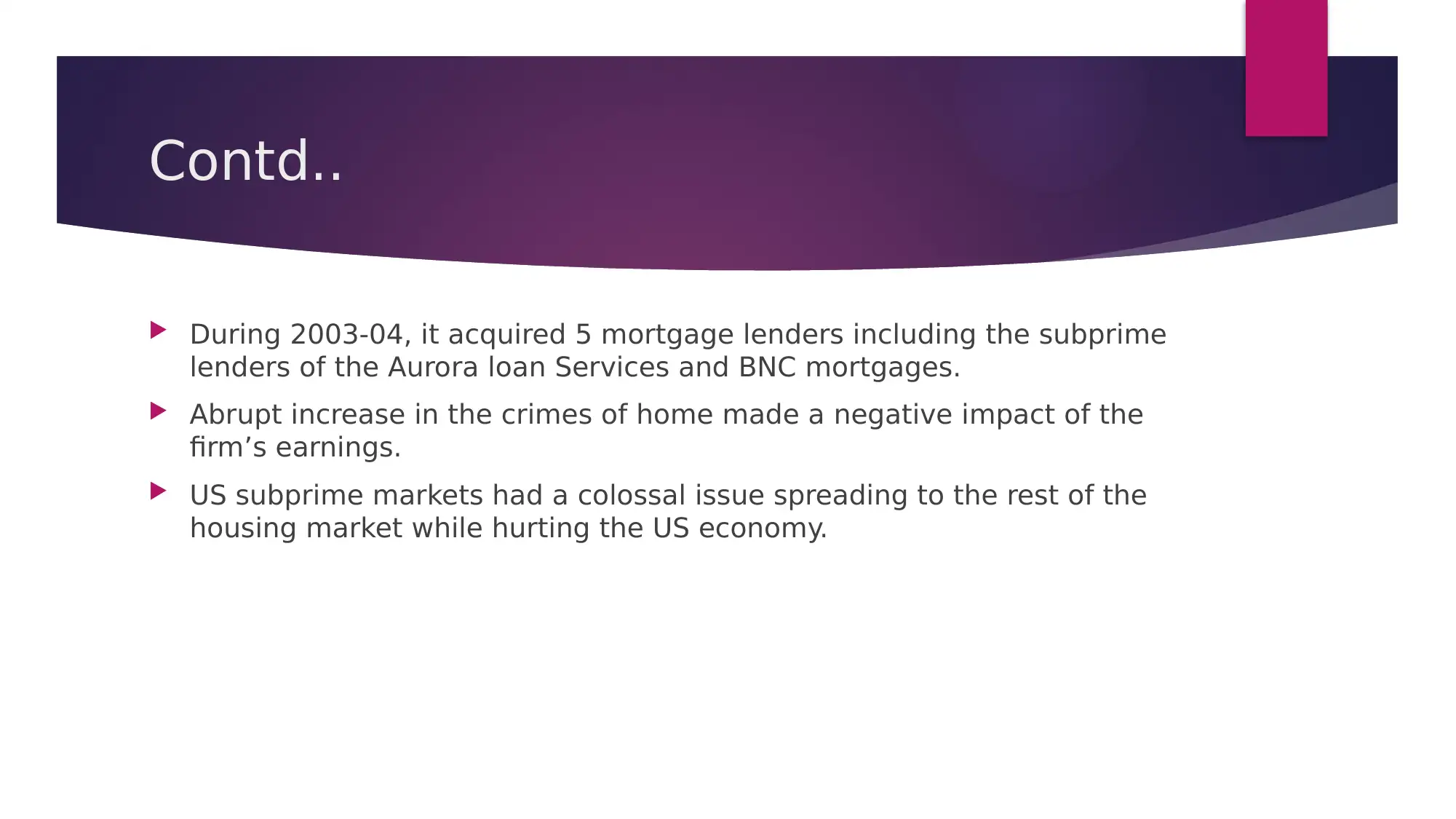
Contd..
During 2003-04, it acquired 5 mortgage lenders including the subprime
lenders of the Aurora loan Services and BNC mortgages.
Abrupt increase in the crimes of home made a negative impact of the
firm’s earnings.
US subprime markets had a colossal issue spreading to the rest of the
housing market while hurting the US economy.
During 2003-04, it acquired 5 mortgage lenders including the subprime
lenders of the Aurora loan Services and BNC mortgages.
Abrupt increase in the crimes of home made a negative impact of the
firm’s earnings.
US subprime markets had a colossal issue spreading to the rest of the
housing market while hurting the US economy.
⊘ This is a preview!⊘
Do you want full access?
Subscribe today to unlock all pages.

Trusted by 1+ million students worldwide
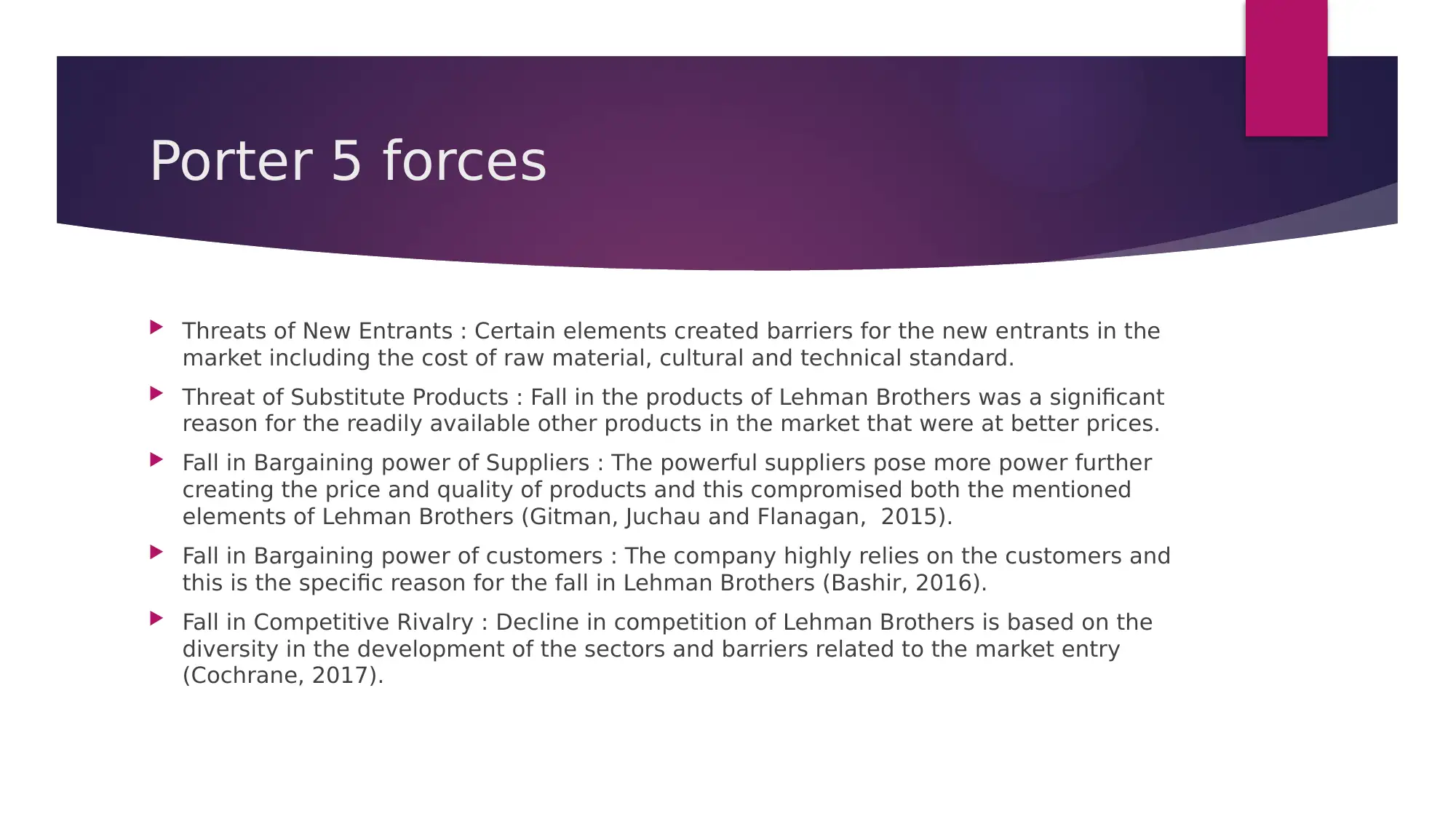
Porter 5 forces
Threats of New Entrants : Certain elements created barriers for the new entrants in the
market including the cost of raw material, cultural and technical standard.
Threat of Substitute Products : Fall in the products of Lehman Brothers was a significant
reason for the readily available other products in the market that were at better prices.
Fall in Bargaining power of Suppliers : The powerful suppliers pose more power further
creating the price and quality of products and this compromised both the mentioned
elements of Lehman Brothers (Gitman, Juchau and Flanagan, 2015).
Fall in Bargaining power of customers : The company highly relies on the customers and
this is the specific reason for the fall in Lehman Brothers (Bashir, 2016).
Fall in Competitive Rivalry : Decline in competition of Lehman Brothers is based on the
diversity in the development of the sectors and barriers related to the market entry
(Cochrane, 2017).
Threats of New Entrants : Certain elements created barriers for the new entrants in the
market including the cost of raw material, cultural and technical standard.
Threat of Substitute Products : Fall in the products of Lehman Brothers was a significant
reason for the readily available other products in the market that were at better prices.
Fall in Bargaining power of Suppliers : The powerful suppliers pose more power further
creating the price and quality of products and this compromised both the mentioned
elements of Lehman Brothers (Gitman, Juchau and Flanagan, 2015).
Fall in Bargaining power of customers : The company highly relies on the customers and
this is the specific reason for the fall in Lehman Brothers (Bashir, 2016).
Fall in Competitive Rivalry : Decline in competition of Lehman Brothers is based on the
diversity in the development of the sectors and barriers related to the market entry
(Cochrane, 2017).
Paraphrase This Document
Need a fresh take? Get an instant paraphrase of this document with our AI Paraphraser

SWOT Analysis
Fall in Strength included the struggle to hold a significant command in
the business because of incompetence of organizational skill, market
leadership and resource (Shoup, 2017).
Weakness include the lack of resources, marketing skills and capability.
Fall in opportunities includes a lack of environmental and social
opportunities of the company for competing in the competitive market
(Härdle, Chen and Overbeck, 2017).
Threats include external and environmental threats creating the major
issues for the decline in performance.
Fall in Strength included the struggle to hold a significant command in
the business because of incompetence of organizational skill, market
leadership and resource (Shoup, 2017).
Weakness include the lack of resources, marketing skills and capability.
Fall in opportunities includes a lack of environmental and social
opportunities of the company for competing in the competitive market
(Härdle, Chen and Overbeck, 2017).
Threats include external and environmental threats creating the major
issues for the decline in performance.

Managerial Performance &
Stockholders Analysis
Main failure was the board of directors since there was an agency
problem.
Another reason was the management system of concern that resulted
in a significant collapse.
Another issue with the higher level directors while the stockholders
were aware of this situation (Pilbeam, 2018).
Employees and shareholders were in a struggle with the agency
problem within the internal management.
Stockholders Analysis
Main failure was the board of directors since there was an agency
problem.
Another reason was the management system of concern that resulted
in a significant collapse.
Another issue with the higher level directors while the stockholders
were aware of this situation (Pilbeam, 2018).
Employees and shareholders were in a struggle with the agency
problem within the internal management.
⊘ This is a preview!⊘
Do you want full access?
Subscribe today to unlock all pages.

Trusted by 1+ million students worldwide
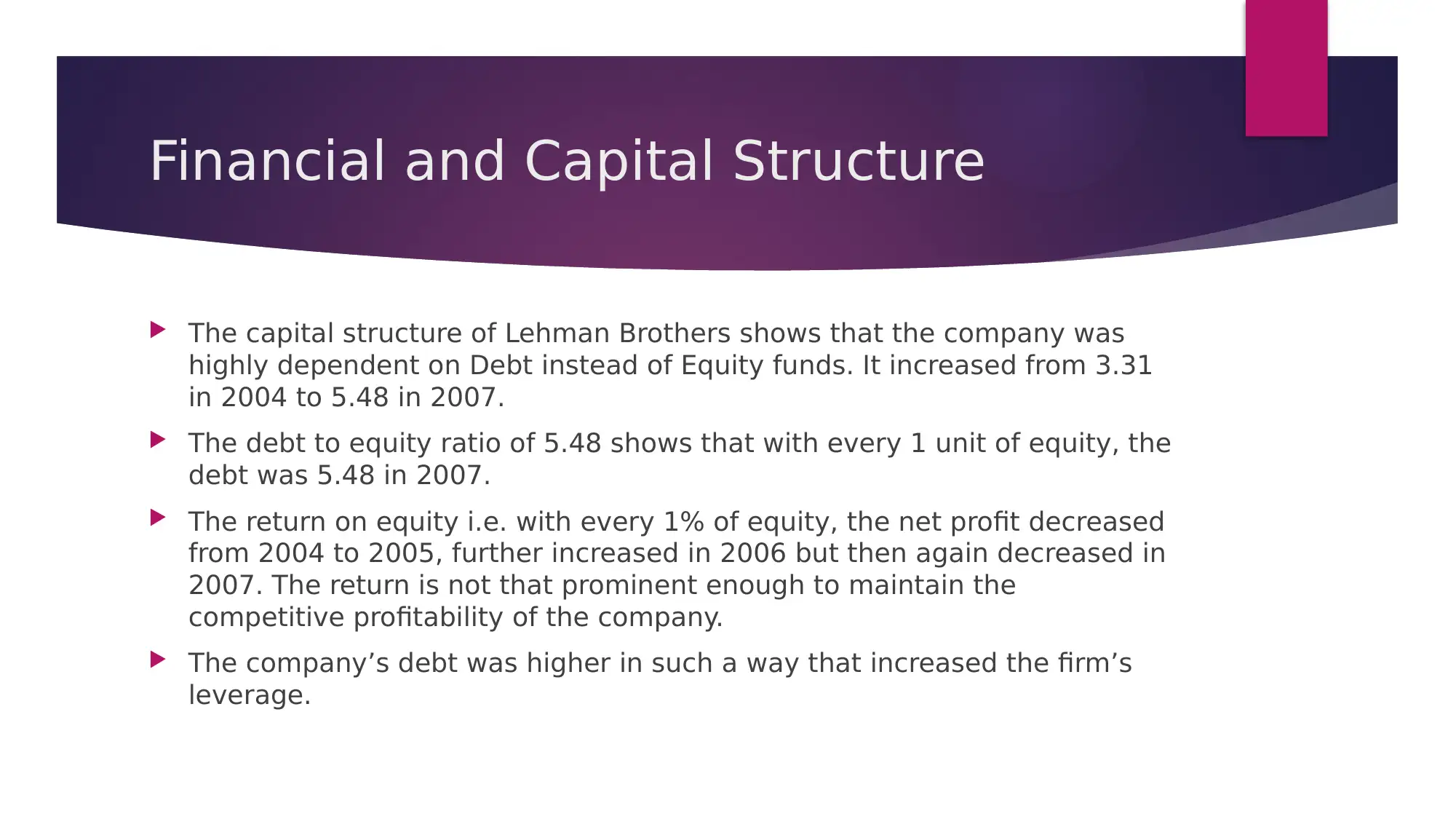
Financial and Capital Structure
The capital structure of Lehman Brothers shows that the company was
highly dependent on Debt instead of Equity funds. It increased from 3.31
in 2004 to 5.48 in 2007.
The debt to equity ratio of 5.48 shows that with every 1 unit of equity, the
debt was 5.48 in 2007.
The return on equity i.e. with every 1% of equity, the net profit decreased
from 2004 to 2005, further increased in 2006 but then again decreased in
2007. The return is not that prominent enough to maintain the
competitive profitability of the company.
The company’s debt was higher in such a way that increased the firm’s
leverage.
The capital structure of Lehman Brothers shows that the company was
highly dependent on Debt instead of Equity funds. It increased from 3.31
in 2004 to 5.48 in 2007.
The debt to equity ratio of 5.48 shows that with every 1 unit of equity, the
debt was 5.48 in 2007.
The return on equity i.e. with every 1% of equity, the net profit decreased
from 2004 to 2005, further increased in 2006 but then again decreased in
2007. The return is not that prominent enough to maintain the
competitive profitability of the company.
The company’s debt was higher in such a way that increased the firm’s
leverage.
Paraphrase This Document
Need a fresh take? Get an instant paraphrase of this document with our AI Paraphraser
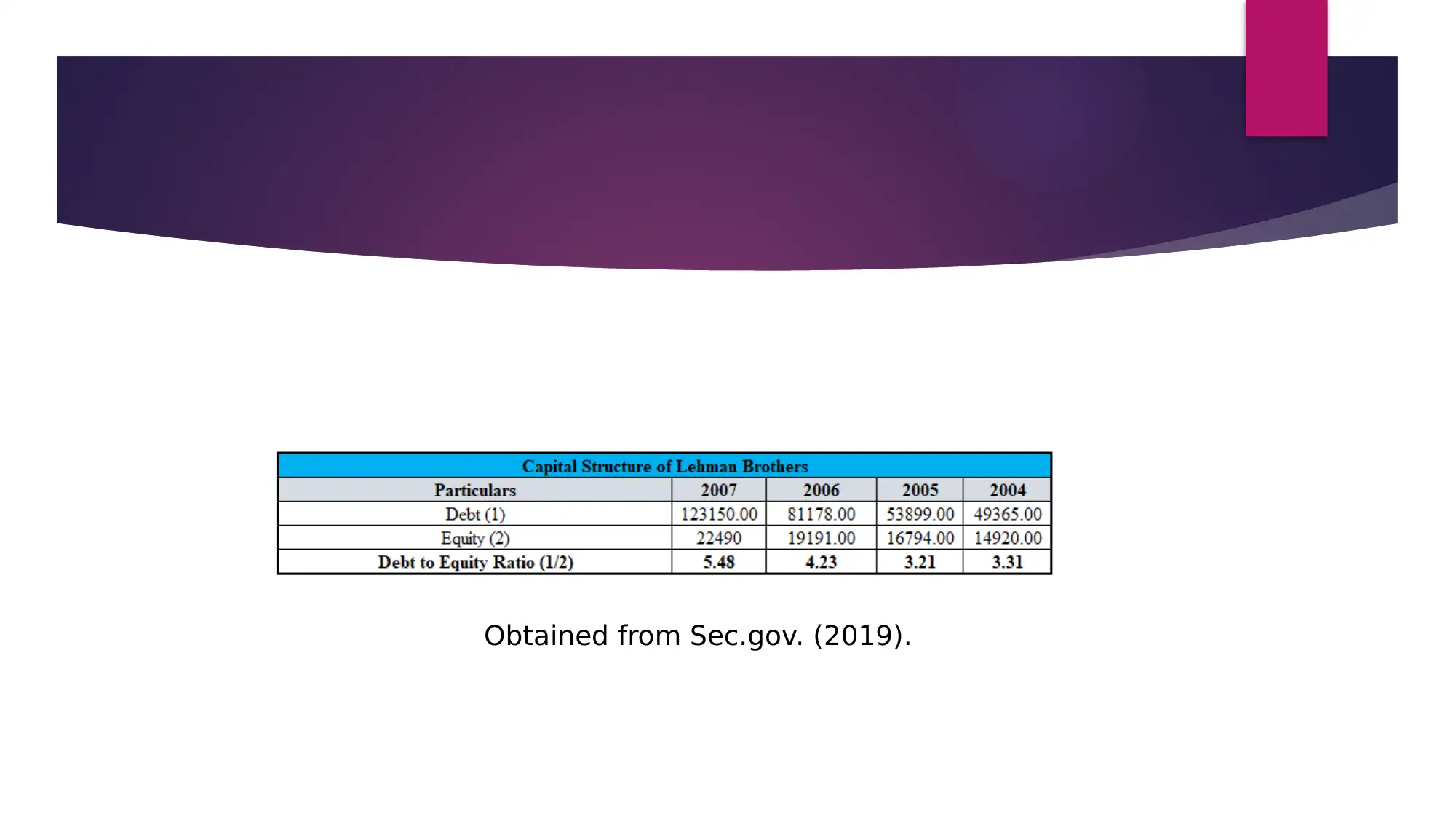
Obtained from Sec.gov. (2019).
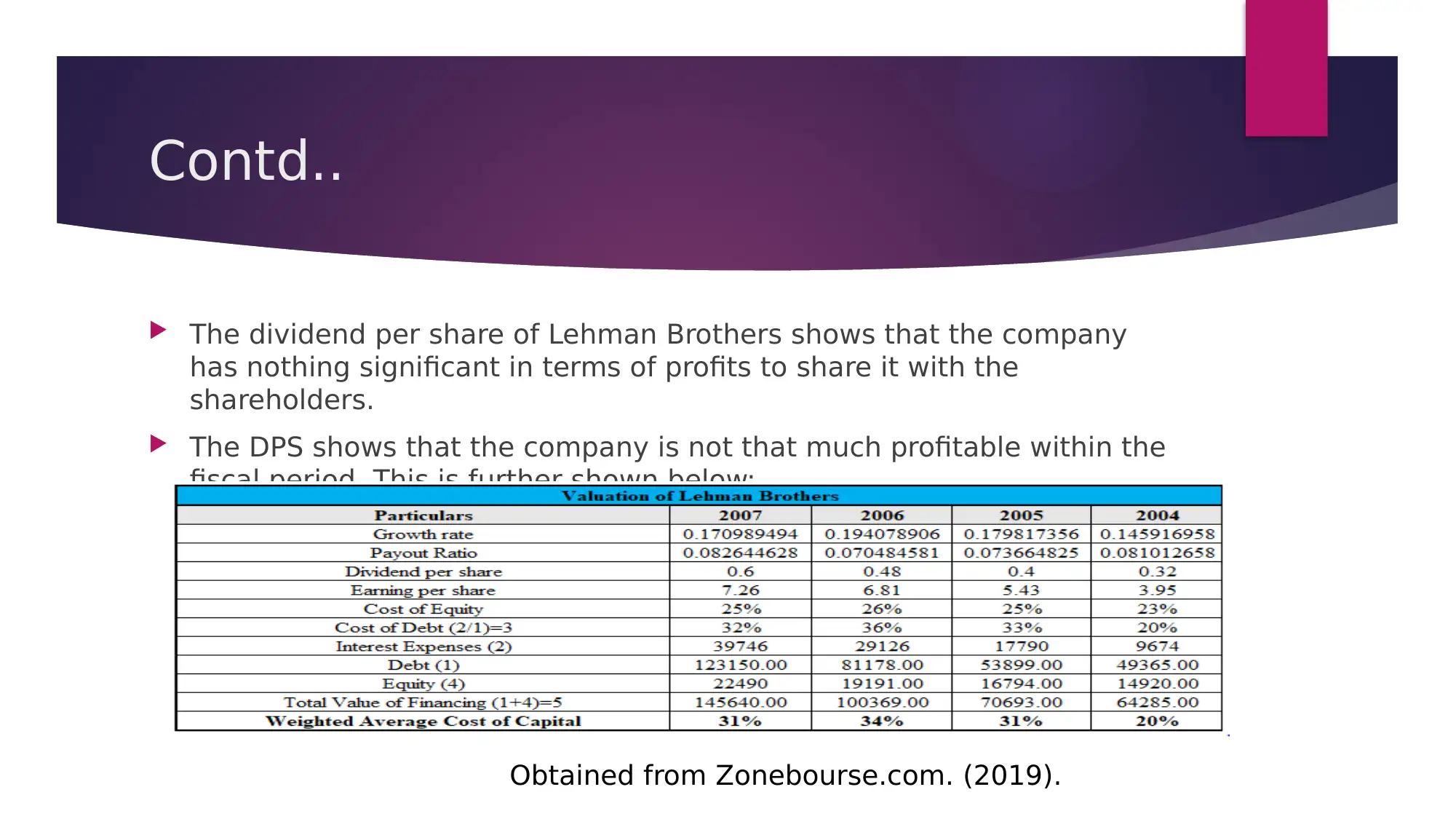
Contd..
The dividend per share of Lehman Brothers shows that the company
has nothing significant in terms of profits to share it with the
shareholders.
The DPS shows that the company is not that much profitable within the
fiscal period. This is further shown below:
Obtained from Zonebourse.com. (2019).
The dividend per share of Lehman Brothers shows that the company
has nothing significant in terms of profits to share it with the
shareholders.
The DPS shows that the company is not that much profitable within the
fiscal period. This is further shown below:
Obtained from Zonebourse.com. (2019).
⊘ This is a preview!⊘
Do you want full access?
Subscribe today to unlock all pages.

Trusted by 1+ million students worldwide
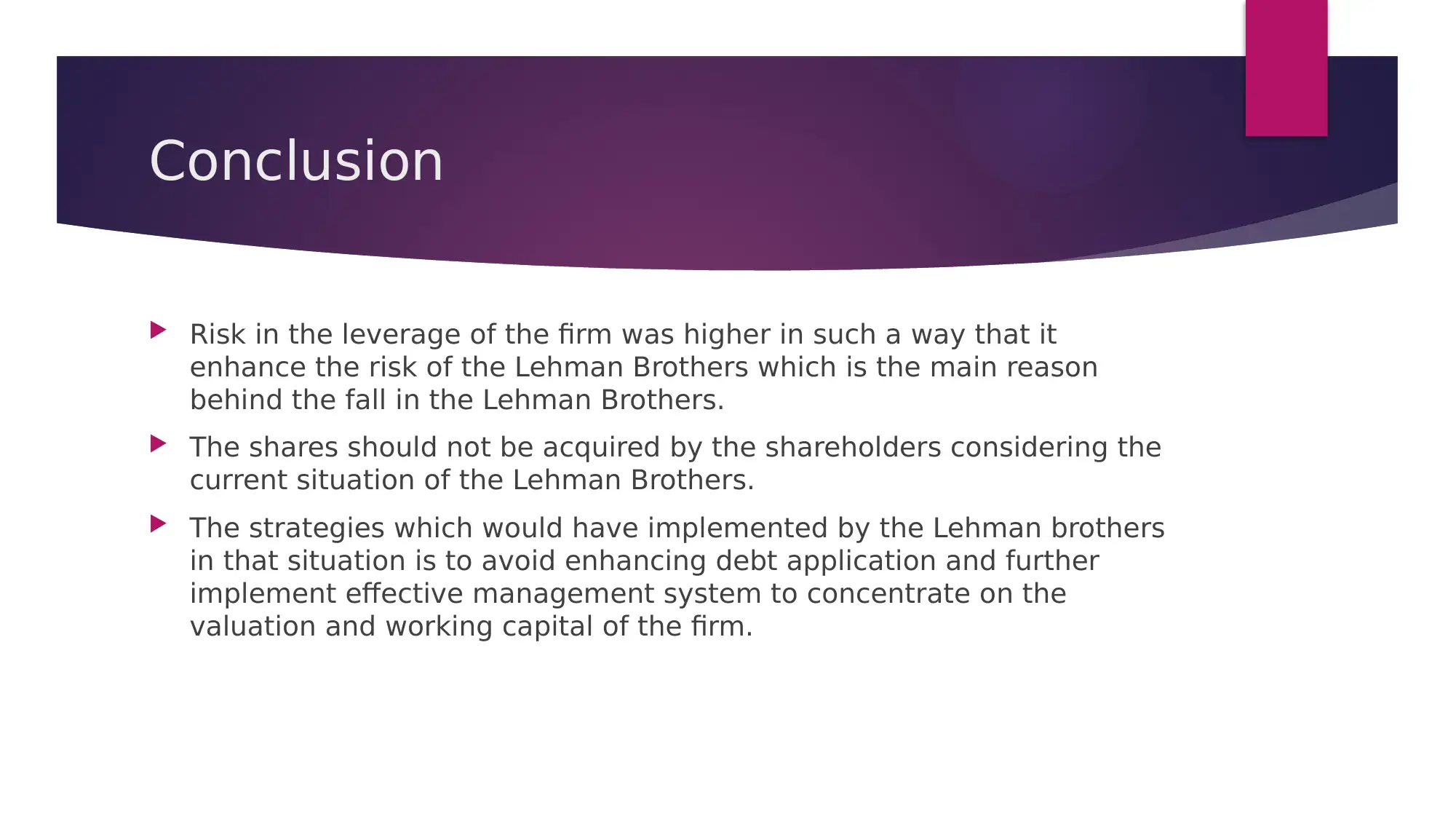
Conclusion
Risk in the leverage of the firm was higher in such a way that it
enhance the risk of the Lehman Brothers which is the main reason
behind the fall in the Lehman Brothers.
The shares should not be acquired by the shareholders considering the
current situation of the Lehman Brothers.
The strategies which would have implemented by the Lehman brothers
in that situation is to avoid enhancing debt application and further
implement effective management system to concentrate on the
valuation and working capital of the firm.
Risk in the leverage of the firm was higher in such a way that it
enhance the risk of the Lehman Brothers which is the main reason
behind the fall in the Lehman Brothers.
The shares should not be acquired by the shareholders considering the
current situation of the Lehman Brothers.
The strategies which would have implemented by the Lehman brothers
in that situation is to avoid enhancing debt application and further
implement effective management system to concentrate on the
valuation and working capital of the firm.
Paraphrase This Document
Need a fresh take? Get an instant paraphrase of this document with our AI Paraphraser

References
Arcand, J.L., Berkes, E. and Panizza, U., 2015. Too much finance?. Journal of Economic Growth, 20(2), pp.105-148.
Bashir, Y., 2016. Effects of treasury single account on public finance management in Nigeria. Research Journal of
Finance and Accounting, 7(6).
Cochrane, J.H., 2017. Macro-finance. Review of Finance, 21(3), pp.945-985.
Gitman, L.J., Juchau, R. and Flanagan, J., 2015. Principles of managerial finance. Pearson Higher Education AU.
Härdle, W.K., Chen, C.Y.H. and Overbeck, L. eds., 2017. Applied quantitative finance (Vol. 2). Springer.
Horst, U., 2018. Introduction to Mathematical Finance.
Pilbeam, K., 2018. Finance & financial markets. Macmillan International Higher Education.
Sec.gov. (2019). [online] Available at: https://www.sec.gov/Archives/edgar/data/806085/000104746906001870/
a2167455z10-k.htm [Accessed 26 Jul. 2019].
Shoup, C., 2017. Public finance. Routledge.
Zonebourse.com. (2019). [online] Available at: https://www.zonebourse.com/NB-PRIVEQPARTN-56192/pdf/87896/NB
%20PRIV%20EQ%20PARTN_Rapport-annuel.pdf [Accessed 26 Jul. 2019].
Arcand, J.L., Berkes, E. and Panizza, U., 2015. Too much finance?. Journal of Economic Growth, 20(2), pp.105-148.
Bashir, Y., 2016. Effects of treasury single account on public finance management in Nigeria. Research Journal of
Finance and Accounting, 7(6).
Cochrane, J.H., 2017. Macro-finance. Review of Finance, 21(3), pp.945-985.
Gitman, L.J., Juchau, R. and Flanagan, J., 2015. Principles of managerial finance. Pearson Higher Education AU.
Härdle, W.K., Chen, C.Y.H. and Overbeck, L. eds., 2017. Applied quantitative finance (Vol. 2). Springer.
Horst, U., 2018. Introduction to Mathematical Finance.
Pilbeam, K., 2018. Finance & financial markets. Macmillan International Higher Education.
Sec.gov. (2019). [online] Available at: https://www.sec.gov/Archives/edgar/data/806085/000104746906001870/
a2167455z10-k.htm [Accessed 26 Jul. 2019].
Shoup, C., 2017. Public finance. Routledge.
Zonebourse.com. (2019). [online] Available at: https://www.zonebourse.com/NB-PRIVEQPARTN-56192/pdf/87896/NB
%20PRIV%20EQ%20PARTN_Rapport-annuel.pdf [Accessed 26 Jul. 2019].
1 out of 11
Related Documents
Your All-in-One AI-Powered Toolkit for Academic Success.
+13062052269
info@desklib.com
Available 24*7 on WhatsApp / Email
![[object Object]](/_next/static/media/star-bottom.7253800d.svg)
Unlock your academic potential
Copyright © 2020–2025 A2Z Services. All Rights Reserved. Developed and managed by ZUCOL.





